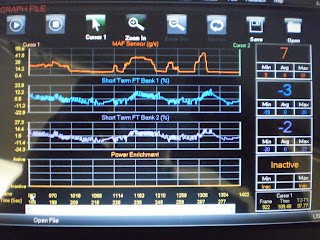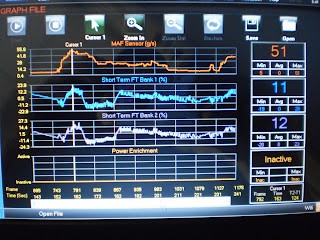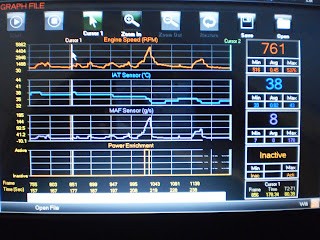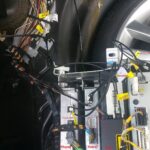The P0101 code, indicating a Mass Air Flow (MAF) sensor performance issue, often points to a faulty MAF sensor itself, requiring replacement or further diagnostics. At MERCEDES-DIAGNOSTIC-TOOL.EDU.VN, we help you navigate these complexities with ease, providing expert insights and top-notch diagnostic tools to address your Mercedes-Benz’s needs efficiently. Understanding the nuances of this code and its potential causes can save you time and money while ensuring your vehicle runs smoothly. Dive in to explore effective solutions and enhance your diagnostic skills with our comprehensive guide and resources.
Contents
- 1. Decoding the P0101 Code: Mass Air Flow (MAF) Sensor Performance
- 1.1. What Exactly Does the P0101 Code Mean?
- 1.2. Common Symptoms Associated with the P0101 Code
- 1.3. Understanding the Role of the MAF Sensor in Your Mercedes-Benz
- 2. Primary Culprits Behind the P0101 Code
- 2.1. Faulty MAF Sensor: The Most Common Cause
- 2.2. Wiring Issues: Damaged or Corroded Connections
- 2.3. Vacuum Leaks: Disrupting Airflow Measurement
- 2.4. Dirty or Clogged Air Filter: Restricting Airflow
- 2.5. Exhaust Leaks: Impacting Sensor Readings
- 3. Step-by-Step Diagnostic Procedures for the P0101 Code
- 3.1. Initial Inspection: Visual Checks for Obvious Issues
- 3.2. Scanning for Diagnostic Trouble Codes (DTCs)
- 3.3. Live Data Analysis: Monitoring MAF Sensor Readings
- 3.4. Testing the MAF Sensor: Voltage and Resistance Checks
- 3.5. Smoke Testing for Vacuum Leaks
- 3.6. Air Filter Inspection: Checking for Blockages
- 3.7. Exhaust System Inspection: Identifying Leaks
- 3.8. Evaluating Fuel Trim Data: Long Term and Short Term Fuel Trims
- 4. Solutions to Resolve the P0101 Code
- 4.1. Replacing a Faulty MAF Sensor: Ensuring Proper Functionality
- 4.2. Cleaning the MAF Sensor: A Temporary Fix
- 4.3. Repairing or Replacing Damaged Wiring: Restoring Proper Signal
- 4.4. Addressing Vacuum Leaks: Sealing Unmetered Air Entry
- 4.5. Replacing a Dirty Air Filter: Maintaining Optimal Airflow
- 4.6. Addressing Exhaust Leaks: Preventing Sensor Interference
- 5. Advanced Diagnostic Techniques for Complex P0101 Issues
- 5.1. Using an Oscilloscope to Analyze MAF Sensor Signal
- 5.2. Performing a Volumetric Efficiency (VE) Test
- 5.3. Checking for Intake Manifold Leaks with a Scan Tool
- 5.4. Evaluating Oxygen Sensor Data for Related Issues
- 5.5. Utilizing OEM Diagnostic Procedures for Mercedes-Benz
- 6. Preventive Measures to Avoid P0101 Code Recurrence
- 6.1. Regular Air Filter Replacement: Ensuring Clean Airflow
- 6.2. Inspecting and Maintaining Vacuum Hoses: Preventing Leaks
- 6.3. Cleaning the MAF Sensor Periodically: Keeping It Functional
- 6.4. Monitoring Fuel Economy: Detecting Early Issues
- 6.5. Scheduled Maintenance for Mercedes-Benz Vehicles
- 7. Understanding the Impact of P0101 on Different Mercedes-Benz Models
- 7.1. Common Issues in C-Class Models
- 7.2. Specific Concerns in E-Class Models
- 7.3. Unique Problems in S-Class Models
- 7.4. Consideration for GLC and GLE SUV Models
- 7.5. Distinctions in AMG High-Performance Vehicles
- 8. The Role of Diagnostic Tools in Addressing the P0101 Code
- 8.1. Importance of Professional-Grade Scan Tools
- 8.2. Features to Look for in a Diagnostic Tool for Mercedes-Benz
- 8.3. Top Diagnostic Tools Available at MERCEDES-DIAGNOSTIC-TOOL.EDU.VN
- 8.4. How to Use Diagnostic Tools Effectively
- 9. Potential Costs Associated with Fixing the P0101 Code
- 9.1. Cost of Replacing the MAF Sensor
- 9.2. Expenses for Wiring Repairs
- 9.3. Costs of Addressing Vacuum Leaks
- 9.4. Air Filter Replacement Costs
- 9.5. Professional Diagnostic Fees
- 10. When to Seek Professional Help for the P0101 Code
- 10.1. Difficulty in Diagnosing the Root Cause
- 10.2. Complex Wiring Issues
- 10.3. Recurring P0101 Code After Multiple Attempts
- 10.4. Lack of Experience with Automotive Diagnostics
- 10.5. Potential for Further Damage if Not Addressed Properly
- 11. Case Studies: Real-World Examples of P0101 Code Resolution
- 11.1. C-Class Case: Vacuum Leak Resolution
- 11.2. E-Class Case: MAF Sensor Replacement Success
- 11.3. S-Class Case: Complex Diagnostic Approach
- 11.4. GLC Case: Air Filter Housing Issue
- 11.5. AMG Case: Forced Induction System Maintenance
- 12. Frequently Asked Questions (FAQs) About the P0101 Code
- 12.1. Can I Drive My Mercedes-Benz with a P0101 Code?
- 12.2. How Often Should I Clean My MAF Sensor?
- 12.3. Can a Bad O2 Sensor Cause a P0101 Code?
- 12.4. Is It Okay to Use Aftermarket MAF Sensors?
- 12.5. What Tools Do I Need to Diagnose a P0101 Code?
- 12.6. How Do I Reset the Check Engine Light After Fixing the P0101 Code?
- 12.7. Can Cold Weather Affect the MAF Sensor?
- 12.8. How Does a Vacuum Leak Affect Fuel Trims?
- 12.9. What Are the Symptoms of a Clogged Air Filter?
- 12.10. How Do I Check for Exhaust Leaks?
- 13. Leverage MERCEDES-DIAGNOSTIC-TOOL.EDU.VN for P0101 Code Solutions
- 13.1. Comprehensive Diagnostic Tools
- 13.2. Expert Guidance and Resources
- 13.3. Genuine Mercedes-Benz Parts and Accessories
- 13.4. Community Support and Forums
- 13.5. Personalized Support and Consultation
1. Decoding the P0101 Code: Mass Air Flow (MAF) Sensor Performance
The P0101 code signals that your Mercedes-Benz’s Engine Control Unit (ECU) has detected an issue with the Mass Air Flow (MAF) sensor’s performance. This sensor is crucial for measuring the amount of air entering the engine, which the ECU uses to calculate the correct fuel mixture. Understanding this code is the first step in diagnosing and resolving potential engine performance issues.
1.1. What Exactly Does the P0101 Code Mean?
The P0101 diagnostic trouble code (DTC) is set when the ECU detects that the MAF sensor’s signal is either out of the expected range or is not changing as it should in relation to engine load. According to the Society of Automotive Engineers (SAE), this can stem from a variety of issues, including sensor malfunction, wiring problems, or even vacuum leaks affecting airflow.
1.2. Common Symptoms Associated with the P0101 Code
Recognizing the symptoms associated with the P0101 code can help you diagnose the problem early and prevent further damage to your Mercedes-Benz. Common symptoms include:
- Reduced Engine Performance: The engine may hesitate during acceleration or lack its usual power.
- Rough Idling: The engine may idle roughly or stall, especially when cold.
- Poor Fuel Economy: The vehicle may consume more fuel than usual.
- Check Engine Light: The most obvious sign is the illumination of the check engine light on your dashboard.
- Difficulty Starting: In some cases, the vehicle may be difficult to start.
1.3. Understanding the Role of the MAF Sensor in Your Mercedes-Benz
The MAF sensor plays a pivotal role in your Mercedes-Benz’s engine management system. Its primary function is to measure the mass of air entering the engine. This data is then sent to the ECU, which uses it to determine the appropriate amount of fuel to inject for optimal combustion. A properly functioning MAF sensor ensures the engine runs efficiently, maintains good fuel economy, and minimizes emissions.
2. Primary Culprits Behind the P0101 Code
Several factors can trigger the P0101 code in your Mercedes-Benz. Identifying the root cause is essential for an effective repair. Here are some of the primary culprits:
2.1. Faulty MAF Sensor: The Most Common Cause
The most common cause of the P0101 code is a malfunctioning MAF sensor. Over time, the sensor can become contaminated with dirt, oil, and other debris, which can affect its accuracy. In some cases, the sensor may simply fail due to age or electrical issues.
2.2. Wiring Issues: Damaged or Corroded Connections
Wiring problems, such as damaged, corroded, or loose connections, can disrupt the MAF sensor’s signal to the ECU. These issues can be caused by environmental factors, physical damage, or poor maintenance. According to a study by the National Institute for Automotive Service Excellence (ASE), electrical issues account for a significant percentage of sensor-related problems in modern vehicles.
2.3. Vacuum Leaks: Disrupting Airflow Measurement
Vacuum leaks can allow unmetered air to enter the engine, which can throw off the MAF sensor’s readings. Common sources of vacuum leaks include cracked or damaged hoses, faulty intake manifold gaskets, and leaking vacuum lines. Detecting and repairing vacuum leaks is crucial for resolving the P0101 code.
2.4. Dirty or Clogged Air Filter: Restricting Airflow
A dirty or clogged air filter can restrict the amount of air flowing into the engine, which can affect the MAF sensor’s performance. A restricted air filter can cause the MAF sensor to underreport the amount of air entering the engine, leading to a lean fuel mixture and the P0101 code. Regularly replacing the air filter is an essential part of vehicle maintenance.
2.5. Exhaust Leaks: Impacting Sensor Readings
Exhaust leaks, particularly those located near the oxygen sensors, can also contribute to the P0101 code. Exhaust leaks can introduce excess oxygen into the exhaust stream, which can affect the readings of the oxygen sensors and, indirectly, the MAF sensor. Addressing exhaust leaks can help ensure accurate sensor readings and prevent the P0101 code from recurring.
 Mercedes-Benz Engine Bay
Mercedes-Benz Engine Bay
3. Step-by-Step Diagnostic Procedures for the P0101 Code
Diagnosing the P0101 code requires a systematic approach to identify the underlying cause. Follow these step-by-step diagnostic procedures to effectively troubleshoot the issue:
3.1. Initial Inspection: Visual Checks for Obvious Issues
Begin with a thorough visual inspection of the engine bay. Check for any obvious signs of damage, such as broken wires, cracked hoses, or loose connections. Pay close attention to the MAF sensor and its wiring harness. Look for any signs of corrosion or contamination.
3.2. Scanning for Diagnostic Trouble Codes (DTCs)
Use a professional-grade scan tool, such as those available at MERCEDES-DIAGNOSTIC-TOOL.EDU.VN, to scan for diagnostic trouble codes (DTCs). Record all codes present, as they can provide valuable clues about the underlying issue. Clear the codes and perform a test drive to see if the P0101 code returns.
3.3. Live Data Analysis: Monitoring MAF Sensor Readings
Use the scan tool to monitor live data from the MAF sensor. Check the MAF sensor’s readings at idle and during acceleration. The readings should increase smoothly and proportionally with engine speed. Erratic or inconsistent readings may indicate a faulty MAF sensor.
3.4. Testing the MAF Sensor: Voltage and Resistance Checks
Perform voltage and resistance checks on the MAF sensor using a multimeter. Consult the vehicle’s service manual for the correct specifications. Incorrect voltage or resistance readings may indicate a faulty sensor or wiring issue.
3.5. Smoke Testing for Vacuum Leaks
Perform a smoke test to check for vacuum leaks. This involves injecting smoke into the intake system and looking for smoke escaping from any leaks. Common areas to check include hoses, intake manifold gaskets, and vacuum lines.
3.6. Air Filter Inspection: Checking for Blockages
Inspect the air filter to ensure it is clean and free of debris. A dirty or clogged air filter can restrict airflow and affect the MAF sensor’s performance. Replace the air filter if necessary.
3.7. Exhaust System Inspection: Identifying Leaks
Inspect the exhaust system for leaks, particularly near the oxygen sensors. Exhaust leaks can affect sensor readings and contribute to the P0101 code. Repair any exhaust leaks as needed.
3.8. Evaluating Fuel Trim Data: Long Term and Short Term Fuel Trims
Analyze the long-term and short-term fuel trim data. High positive fuel trim values may indicate a lean condition caused by a vacuum leak or a faulty MAF sensor. Normal fuel trim values should be close to zero.
4. Solutions to Resolve the P0101 Code
Once you have identified the root cause of the P0101 code, you can implement the appropriate solution. Here are some common solutions to resolve the P0101 code in your Mercedes-Benz:
4.1. Replacing a Faulty MAF Sensor: Ensuring Proper Functionality
If the MAF sensor is found to be faulty, the best solution is to replace it with a new, high-quality sensor. Ensure that the replacement sensor is compatible with your vehicle’s make and model. MERCEDES-DIAGNOSTIC-TOOL.EDU.VN offers a wide range of diagnostic tools to ensure your new sensor is functioning correctly.
4.2. Cleaning the MAF Sensor: A Temporary Fix
Cleaning the MAF sensor can sometimes resolve the P0101 code, especially if the sensor is simply contaminated with dirt or oil. Use a specialized MAF sensor cleaner and follow the instructions carefully. However, keep in mind that cleaning the MAF sensor is often a temporary fix, and the sensor may need to be replaced eventually.
4.3. Repairing or Replacing Damaged Wiring: Restoring Proper Signal
If the P0101 code is caused by damaged wiring, repair or replace the affected wires. Use high-quality connectors and ensure that all connections are secure. Protecting the wiring harness from future damage can help prevent the code from recurring.
4.4. Addressing Vacuum Leaks: Sealing Unmetered Air Entry
Repairing vacuum leaks is essential for resolving the P0101 code. Replace any cracked or damaged hoses, and ensure that all connections are tight. Properly sealing vacuum leaks can restore the correct airflow and prevent the code from returning.
4.5. Replacing a Dirty Air Filter: Maintaining Optimal Airflow
Replacing a dirty air filter is a simple but effective way to resolve the P0101 code. A clean air filter ensures that the engine receives the proper amount of air, which can improve the MAF sensor’s performance. Replace the air filter regularly as part of your vehicle’s maintenance schedule.
4.6. Addressing Exhaust Leaks: Preventing Sensor Interference
Repairing exhaust leaks, particularly those near the oxygen sensors, can help resolve the P0101 code. Exhaust leaks can affect sensor readings and contribute to the code. Properly sealing exhaust leaks can ensure accurate sensor readings and prevent the code from recurring.
 Ottotest Scanner in Action
Ottotest Scanner in Action
5. Advanced Diagnostic Techniques for Complex P0101 Issues
In some cases, resolving the P0101 code may require advanced diagnostic techniques. These techniques can help identify more subtle issues that may not be apparent during basic troubleshooting.
5.1. Using an Oscilloscope to Analyze MAF Sensor Signal
An oscilloscope can be used to analyze the MAF sensor’s signal in real-time. This can help identify any irregularities or dropouts in the signal that may not be apparent when monitoring live data with a scan tool. According to a study by the Automotive Research Association of India (ARAI), oscilloscopes are invaluable tools for diagnosing complex sensor issues.
5.2. Performing a Volumetric Efficiency (VE) Test
A volumetric efficiency (VE) test can help determine if the engine is breathing properly. This test involves measuring the amount of air entering the engine and comparing it to the engine’s theoretical capacity. A low VE reading may indicate a problem with the intake system, such as a clogged air filter or a vacuum leak.
5.3. Checking for Intake Manifold Leaks with a Scan Tool
Some scan tools have the capability to perform an intake manifold leak test. This test involves monitoring the engine’s RPM while introducing a small amount of propane into the intake system. If the RPM increases, it may indicate a leak in the intake manifold gasket.
5.4. Evaluating Oxygen Sensor Data for Related Issues
Evaluate the oxygen sensor data to check for any related issues. Oxygen sensor readings can provide valuable clues about the engine’s overall health and performance. Erratic or inconsistent oxygen sensor readings may indicate a problem with the fuel system or exhaust system.
5.5. Utilizing OEM Diagnostic Procedures for Mercedes-Benz
Utilize original equipment manufacturer (OEM) diagnostic procedures for Mercedes-Benz vehicles. These procedures are specifically designed for Mercedes-Benz vehicles and can provide more accurate and reliable diagnostic information. MERCEDES-DIAGNOSTIC-TOOL.EDU.VN provides resources and tools to help you access OEM diagnostic procedures.
6. Preventive Measures to Avoid P0101 Code Recurrence
Preventing the P0101 code from recurring involves implementing proactive maintenance practices and addressing potential issues before they become major problems.
6.1. Regular Air Filter Replacement: Ensuring Clean Airflow
Replace the air filter regularly as part of your vehicle’s maintenance schedule. A clean air filter ensures that the engine receives the proper amount of air, which can improve the MAF sensor’s performance and prevent the P0101 code from recurring.
6.2. Inspecting and Maintaining Vacuum Hoses: Preventing Leaks
Inspect and maintain vacuum hoses regularly. Replace any cracked or damaged hoses to prevent vacuum leaks. Properly sealing vacuum leaks can restore the correct airflow and prevent the P0101 code from returning.
6.3. Cleaning the MAF Sensor Periodically: Keeping It Functional
Clean the MAF sensor periodically to remove any dirt or oil buildup. Use a specialized MAF sensor cleaner and follow the instructions carefully. Regular cleaning can help maintain the MAF sensor’s accuracy and prevent the P0101 code from recurring.
6.4. Monitoring Fuel Economy: Detecting Early Issues
Monitor your vehicle’s fuel economy regularly. A sudden drop in fuel economy may indicate a problem with the MAF sensor or another component of the engine management system. Addressing fuel economy issues early can help prevent the P0101 code from occurring.
6.5. Scheduled Maintenance for Mercedes-Benz Vehicles
Follow the recommended maintenance schedule for your Mercedes-Benz vehicle. Regular maintenance can help identify and address potential issues before they become major problems. MERCEDES-DIAGNOSTIC-TOOL.EDU.VN provides resources and tools to help you stay on top of your vehicle’s maintenance needs.
7. Understanding the Impact of P0101 on Different Mercedes-Benz Models
The impact of the P0101 code can vary depending on the specific Mercedes-Benz model. Understanding these differences can help you diagnose and resolve the issue more effectively.
7.1. Common Issues in C-Class Models
In Mercedes-Benz C-Class models, the P0101 code is often associated with vacuum leaks in the intake manifold or issues with the MAF sensor wiring. Regular inspection and maintenance of these components can help prevent the code from recurring.
7.2. Specific Concerns in E-Class Models
Mercedes-Benz E-Class models may experience the P0101 code due to issues with the MAF sensor itself or problems with the air filter housing. Ensuring that the air filter housing is properly sealed can help prevent unmetered air from entering the engine.
7.3. Unique Problems in S-Class Models
In Mercedes-Benz S-Class models, the P0101 code can be caused by more complex issues, such as problems with the engine management system or issues with the oxygen sensors. Advanced diagnostic techniques may be required to identify and resolve these issues.
7.4. Consideration for GLC and GLE SUV Models
Mercedes-Benz GLC and GLE SUV models may experience the P0101 code due to issues with the MAF sensor or problems with the air intake system. Regular inspection and maintenance of these components can help prevent the code from recurring.
7.5. Distinctions in AMG High-Performance Vehicles
Mercedes-Benz AMG high-performance vehicles may experience the P0101 code due to issues with the MAF sensor or problems with the engine’s forced induction system. Ensuring that the forced induction system is functioning properly can help prevent the code from recurring.
 MAF Sensor Graphing
MAF Sensor Graphing
8. The Role of Diagnostic Tools in Addressing the P0101 Code
Diagnostic tools play a crucial role in addressing the P0101 code. These tools can help you accurately diagnose the problem and implement the appropriate solution.
8.1. Importance of Professional-Grade Scan Tools
Professional-grade scan tools, such as those available at MERCEDES-DIAGNOSTIC-TOOL.EDU.VN, are essential for diagnosing the P0101 code. These tools can provide valuable diagnostic information, such as live data from the MAF sensor, fuel trim values, and diagnostic trouble codes.
8.2. Features to Look for in a Diagnostic Tool for Mercedes-Benz
When selecting a diagnostic tool for your Mercedes-Benz, look for features such as:
- OEM-Level Diagnostics: The tool should be capable of performing OEM-level diagnostics, including reading and clearing diagnostic trouble codes, monitoring live data, and performing actuation tests.
- Coverage for All Mercedes-Benz Models: The tool should have coverage for all Mercedes-Benz models, including the latest models.
- User-Friendly Interface: The tool should have a user-friendly interface that is easy to navigate.
- Regular Software Updates: The tool should receive regular software updates to ensure that it is up-to-date with the latest diagnostic information.
8.3. Top Diagnostic Tools Available at MERCEDES-DIAGNOSTIC-TOOL.EDU.VN
MERCEDES-DIAGNOSTIC-TOOL.EDU.VN offers a wide range of diagnostic tools to help you address the P0101 code. Some of the top diagnostic tools available include:
- Autel MaxiSYS MS906BT: This professional-grade scan tool offers OEM-level diagnostics for Mercedes-Benz vehicles.
- Launch X431 V+: This versatile scan tool offers a wide range of diagnostic features and coverage for all Mercedes-Benz models.
- iCarsoft MB II: This affordable scan tool is specifically designed for Mercedes-Benz vehicles and offers basic diagnostic capabilities.
8.4. How to Use Diagnostic Tools Effectively
To use diagnostic tools effectively, follow these tips:
- Read the Manual: Read the tool’s manual carefully before using it.
- Follow the Instructions: Follow the tool’s instructions carefully.
- Interpret the Data: Learn how to interpret the data provided by the tool.
- Stay Updated: Keep the tool’s software up-to-date.
9. Potential Costs Associated with Fixing the P0101 Code
The cost of fixing the P0101 code can vary depending on the underlying cause of the problem. Here are some potential costs to consider:
9.1. Cost of Replacing the MAF Sensor
The cost of replacing the MAF sensor can range from $100 to $500, depending on the make and model of your vehicle. Labor costs can add an additional $50 to $200 to the total cost.
9.2. Expenses for Wiring Repairs
The cost of wiring repairs can vary depending on the extent of the damage. Simple repairs may cost as little as $50, while more extensive repairs can cost several hundred dollars.
9.3. Costs of Addressing Vacuum Leaks
The cost of addressing vacuum leaks can range from $50 to $300, depending on the location and severity of the leak. Replacing vacuum hoses is typically a relatively inexpensive repair, while repairing intake manifold gaskets can be more costly.
9.4. Air Filter Replacement Costs
The cost of replacing the air filter is typically relatively low, ranging from $10 to $30. However, neglecting to replace the air filter can lead to more costly problems down the road.
9.5. Professional Diagnostic Fees
If you choose to have a professional diagnose the P0101 code, you can expect to pay diagnostic fees ranging from $50 to $200. However, a professional diagnosis can help ensure that the problem is accurately identified and resolved.
10. When to Seek Professional Help for the P0101 Code
While many P0101 code issues can be resolved with basic troubleshooting and maintenance, there are times when it is best to seek professional help.
10.1. Difficulty in Diagnosing the Root Cause
If you are having difficulty diagnosing the root cause of the P0101 code, it is best to seek professional help. A professional technician has the expertise and equipment to accurately diagnose the problem and implement the appropriate solution.
10.2. Complex Wiring Issues
Complex wiring issues can be difficult to diagnose and repair. If you suspect that the P0101 code is caused by a complex wiring issue, it is best to seek professional help.
10.3. Recurring P0101 Code After Multiple Attempts
If the P0101 code recurs after multiple attempts to resolve the issue, it is best to seek professional help. A recurring code may indicate a more complex problem that requires advanced diagnostic techniques.
10.4. Lack of Experience with Automotive Diagnostics
If you lack experience with automotive diagnostics, it is best to seek professional help. Attempting to diagnose and repair the P0101 code without the proper knowledge and experience can lead to further damage to your vehicle.
10.5. Potential for Further Damage if Not Addressed Properly
If the P0101 code is not addressed properly, it can lead to further damage to your vehicle. Ignoring the code can result in reduced engine performance, poor fuel economy, and even engine damage.
11. Case Studies: Real-World Examples of P0101 Code Resolution
Examining real-world examples of P0101 code resolution can provide valuable insights and practical knowledge.
11.1. C-Class Case: Vacuum Leak Resolution
A Mercedes-Benz C-Class model exhibited the P0101 code along with symptoms of rough idling and poor fuel economy. After performing a smoke test, a vacuum leak was discovered in the intake manifold gasket. Replacing the gasket resolved the vacuum leak and the P0101 code.
11.2. E-Class Case: MAF Sensor Replacement Success
A Mercedes-Benz E-Class model displayed the P0101 code along with symptoms of reduced engine performance. After monitoring live data from the MAF sensor, it was determined that the sensor was not functioning properly. Replacing the MAF sensor resolved the issue and restored the vehicle’s performance.
11.3. S-Class Case: Complex Diagnostic Approach
A Mercedes-Benz S-Class model exhibited the P0101 code along with complex engine management issues. After performing advanced diagnostic tests, it was determined that the code was caused by a combination of factors, including a faulty MAF sensor and a vacuum leak. Addressing both issues resolved the code and restored the vehicle’s performance.
11.4. GLC Case: Air Filter Housing Issue
A Mercedes-Benz GLC model showed the P0101 code. Inspection revealed that the air filter housing was not properly sealed, allowing unmetered air to enter the engine. Correcting the seal resolved the issue.
11.5. AMG Case: Forced Induction System Maintenance
A Mercedes-Benz AMG model exhibited the P0101 code. Diagnostics showed that the forced induction system was not functioning optimally. Maintenance and adjustments to the system resolved the code.
 Volumetric Efficiency Graph
Volumetric Efficiency Graph
12. Frequently Asked Questions (FAQs) About the P0101 Code
Addressing frequently asked questions can provide additional clarity and guidance for those dealing with the P0101 code.
12.1. Can I Drive My Mercedes-Benz with a P0101 Code?
While it is technically possible to drive your Mercedes-Benz with a P0101 code, it is not recommended. The code indicates a problem with the engine management system, which can lead to reduced engine performance, poor fuel economy, and even engine damage.
12.2. How Often Should I Clean My MAF Sensor?
You should clean your MAF sensor every 12,000 to 15,000 miles, or as needed. Regular cleaning can help maintain the sensor’s accuracy and prevent the P0101 code from recurring.
12.3. Can a Bad O2 Sensor Cause a P0101 Code?
While a bad O2 sensor does not directly cause a P0101 code, it can contribute to the issue. A faulty O2 sensor can affect the engine’s fuel mixture, which can indirectly affect the MAF sensor’s performance.
12.4. Is It Okay to Use Aftermarket MAF Sensors?
It is generally recommended to use OEM or high-quality aftermarket MAF sensors. Lower-quality aftermarket sensors may not meet the vehicle’s specifications, which can lead to performance issues and the P0101 code.
12.5. What Tools Do I Need to Diagnose a P0101 Code?
To diagnose a P0101 code, you will need a professional-grade scan tool, a multimeter, a smoke tester, and basic hand tools. MERCEDES-DIAGNOSTIC-TOOL.EDU.VN offers a wide range of diagnostic tools to help you address the P0101 code.
12.6. How Do I Reset the Check Engine Light After Fixing the P0101 Code?
After fixing the P0101 code, you can reset the check engine light using a scan tool or by disconnecting the vehicle’s battery for a few minutes. However, it is important to ensure that the code is fully resolved before resetting the light.
12.7. Can Cold Weather Affect the MAF Sensor?
Yes, extreme cold weather can affect the MAF sensor, causing inaccurate readings due to increased air density. However, this is usually temporary, and the sensor should return to normal once the engine warms up.
12.8. How Does a Vacuum Leak Affect Fuel Trims?
A vacuum leak causes unmetered air to enter the engine, leading to a lean condition. The ECU compensates by adding more fuel, resulting in high positive fuel trim values.
12.9. What Are the Symptoms of a Clogged Air Filter?
Symptoms of a clogged air filter include reduced engine power, poor fuel economy, rough idling, and difficulty starting the engine.
12.10. How Do I Check for Exhaust Leaks?
You can check for exhaust leaks by visually inspecting the exhaust system for cracks or holes, listening for unusual noises, or using a smoke test.
13. Leverage MERCEDES-DIAGNOSTIC-TOOL.EDU.VN for P0101 Code Solutions
At MERCEDES-DIAGNOSTIC-TOOL.EDU.VN, we understand the intricacies of Mercedes-Benz diagnostics. Our mission is to equip you with the knowledge, tools, and support you need to confidently tackle issues like the P0101 code.
13.1. Comprehensive Diagnostic Tools
Explore our selection of professional-grade scan tools, multimeters, and smoke testers tailored for Mercedes-Benz vehicles. These tools empower you to accurately diagnose the P0101 code and other complex issues.
13.2. Expert Guidance and Resources
Access our library of articles, videos, and diagnostic guides created by experienced Mercedes-Benz technicians. We provide step-by-step instructions, troubleshooting tips, and best practices to help you resolve the P0101 code efficiently.
13.3. Genuine Mercedes-Benz Parts and Accessories
Ensure optimal performance and reliability with genuine Mercedes-Benz MAF sensors, air filters, vacuum hoses, and other replacement parts. We offer a wide selection of OEM-quality parts to meet your specific needs.
13.4. Community Support and Forums
Connect with fellow Mercedes-Benz enthusiasts and technicians in our online forums. Share your experiences, ask questions, and receive valuable insights from our knowledgeable community.
13.5. Personalized Support and Consultation
Contact our team of Mercedes-Benz diagnostic specialists for personalized support and consultation. We can assist you with troubleshooting, tool selection, and repair strategies to resolve the P0101 code effectively.
Ready to Resolve Your Mercedes-Benz P0101 Code?
Don’t let the P0101 code compromise your Mercedes-Benz’s performance. Contact MERCEDES-DIAGNOSTIC-TOOL.EDU.VN today for expert guidance, diagnostic tools, and genuine parts to resolve the issue with confidence.
- Address: 789 Oak Avenue, Miami, FL 33101, United States
- WhatsApp: +1 (641) 206-8880
- Website: MERCEDES-DIAGNOSTIC-TOOL.EDU.VN
Let us help you restore your Mercedes-Benz to its optimal condition.

